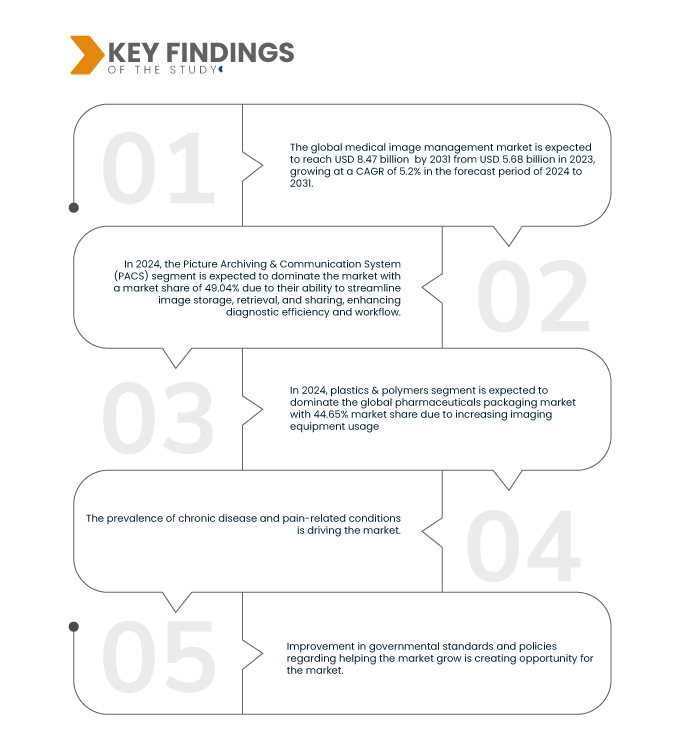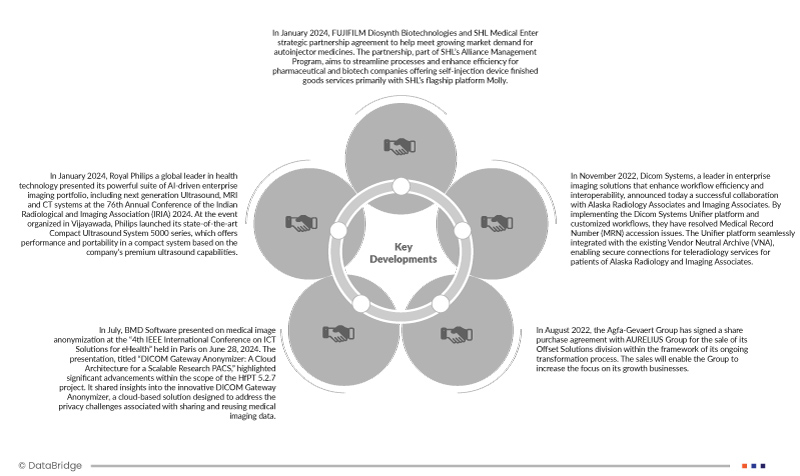The rising demand for early disease detection significantly drives the medical image management market by necessitating advanced imaging technologies and efficient data management systems. With a growing awareness of the benefits of catching illnesses early, there's an increased need for efficient management of medical images, prompting healthcare providers to adopt sophisticated imaging modalities such as MRI, CT scans, and ultrasound. This includes storage, retrieval, and analysis of scans, X-rays, and other visual data. Effective medical image management systems allow doctors to access patient data quickly and easily, facilitating earlier diagnoses and potentially improving treatment outcomes. Early detection can not only improve patient prognosis but also reduce overall healthcare costs by enabling preventative measures and avoiding the need for more expensive interventions later on. Medical facilities are investing in state-of-the-art image management systems to streamline workflows, enhance diagnostic accuracy, and improve patient outcomes. The push for digital healthcare transformation and compliance with stringent regulatory standards are encouraging the adoption of comprehensive image management systems, ensuring data security, interoperability, and efficient healthcare delivery. As the demand for early disease detection rises, so too does the need for robust medical image management solutions.
Access Full Report @ https://www.databridgemarketresearch.com/ko/reports/global-medical-image-management-market
Data Bridge Market Research analyzes that the Medical Image Management Market is expected to reach USD 8.47 billion by 2031 from USD 5.66 billion in 2023, growing at a CAGR of 5.2% in the forecast period of 2024 to 2031.
Key Findings of the Study
Increasing Imaging Equipment Usage
The increasing usage of imaging equipment acts as a significant driver in the medical image management market by creating a substantial volume of diagnostic data that necessitates advanced management solutions. As healthcare providers rely more heavily on imaging technologies like MRI, CT scans, X-rays, and ultrasound for accurate diagnostics and treatment planning, the sheer volume of generated images grows exponentially. This surge in imaging data demands robust medical image management systems to ensure efficient storage, retrieval, and analysis. These systems facilitate streamlined workflows and improve diagnostic accuracy by providing quick access to high-quality images and integrating them seamlessly into electronic health records. Additionally, the growing complexity and resolution of imaging modalities require sophisticated software capable of handling large datasets and enhancing image processing capabilities. With the healthcare industry’s push towards digital transformation, there is an increasing emphasis on interoperability and data security, further driving the adoption of comprehensive image management solutions. These systems not only support regulatory compliance but also enable advanced functionalities such as 3D reconstruction, image fusion, and AI-driven diagnostics, thereby enhancing clinical decision-making and patient outcomes. As a result, the medical image management market is experiencing significant growth, propelled by the rising utilization of imaging equipment and the consequent need for efficient data management solutions.
Report Scope and Market Segmentation
|
Report Metric
|
Details
|
|
Forecast Period
|
2024-2031
|
|
Base Year
|
2023
|
|
Historic Year
|
2022 (Customizable to 2016–2021)
|
|
Quantitative Units
|
Revenue in USD Billion
|
|
Segments Covered
|
Product (Picture Archiving & Communication System (PACS), Vendor Neutral Archives (VNA), Application-Independent Clinical Archive (AICA), Enterprise Viewers/Universal Viewers), Delivery Model (Hybrid, Web/Cloud Based and On Premises), Specialty (Surgery, Oncology, Dental, and Others), End User (Hospitals, Radiology Chains/Centers, Ambulatory Surgery Center, and Others) And Distribution Channel (Direct Tenders, Third Party Administrators, and Others)
|
|
Countries Covered
|
U.S., Canada, Mexico, Germany, Italy, U.K., France, Switzerland, Spain, Russia, Turkey, Belgium, Netherlands, rest of Europe, China, India, South Korea, Japan, Thailand, Australia, Singapore, Indonesia, Malaysia, Philippines, Rest of Asia-Pacific, Brazil, Argentina, rest of South America, Saudi Arabia, United Arab Emirates, South Africa, Egypt, Israel and rest of Middle East and Africa
|
|
Market Players Covered
|
Agfa-Gevaert Group (Belgium), FUJIFILM Corporation (Japan), Koninklijke Philips N.V. (Europe), Sectra AB (Europe), and GE HealthCare (USA) among others.
|
|
Data Points Covered in the Report
|
In addition to the insights on market scenarios such as market value, growth rate, segmentation, geographical coverage, and major players, the market reports curated by the Data Bridge Market Research also include in-depth expert analysis, geographically represented company-wise production and capacity, network layouts of distributors and partners, detailed and updated price trend analysis and deficit analysis of supply chain and demand.
|
Segment Analysis
Medical image management market is segmented into segmented into five notable segments based on product, delivery model, specialty, end user, and distribution channel.
- Based on product, the market is segmented into picture archiving & communication system (PACS), vendor neutral archives (VNA), application-independent clinical archive (AICA), enterprise viewers/ universal viewers
In 2024, the picture archiving & communication system (PACS) of the product segment is expected to dominate the market
In 2024, the picture archiving & communication system (PACS) segment is expected to dominate the market with a market share of 49.04% due to their ability to streamline image storage, retrieval, and sharing, enhancing diagnostic efficiency and workflow.
- Based on delivery model, the market is segmented into hybrid, web/cloud based and on premises
In 2024, the delivery model of the offering segment is expected to dominate the market
In 2024, the hybrid segment is expected to dominate the market with a market share of 47.83% due to its flexible integration of on-premises and cloud-based solutions, optimizing both data security and accessibility.
- Based on specialty, the market is segmented into surgery, oncology, dental and others. In 2024, the surgery segment is expected to dominate the market with a market share of 46.06%
- Based on end user, the market is segmented into hospitals, radiology chains/centres, ambulatory surgery centre and others. In 2024, the hospital segment is expected to dominate the market with a market share of 46.61%
- Based on distribution channel, the market is segmented into direct tenders, third party administrators, and others. In 2024, the direct tenders segment is expected to dominate the market with a market share of 44.09%
Major Players
Data Bridge Market Research recognizes the following companies as the major Medical Image Management market players in the market that include Agfa-Gevaert Group (Belgium), FUJIFILM Corporation (Japan), Koninklijke Philips N.V.(Europe), Sectra AB (Europe) and GE HealthCare (USA) among others.
Market Development
- In January 2024, FUJIFILM Diosynth Biotechnologies and SHL Medical Enter strategic partnership agreement to help meet growing market demand for autoinjector medicines. The partnership, part of SHL’s Alliance Management Program, aims to streamline processes and enhance efficiency for pharmaceutical and biotech companies offering self-injection device finished goods services primarily with SHL’s flagship platform Molly
- In January 2024, Royal Philips a global leader in health technology presented its powerful suite of AI-driven enterprise imaging portfolio, including next generation Ultrasound, MRI and CT systems at the 76th Annual Conference of the Indian Radiological and Imaging Association (IRIA) 2024. At the event organized in Vijayawada, Philips launched its state-of-the-art Compact Ultrasound System 5000 series, which offers performance and portability in a compact system based on the company’s premium ultrasound capabilities
- In July, BMD Software presented on medical image anonymization at the “4th IEEE International Conference on ICT Solutions for eHealth” held in Paris on June 28, 2024. The presentation, titled “DICOM Gateway Anonymizer: A Cloud Architecture for a Scalable Research PACS,” highlighted significant advancements within the scope of the HfPT 5.2.7 project. It shared insights into the innovative DICOM Gateway Anonymizer, a cloud-based solution designed to address the privacy challenges associated with sharing and reusing medical imaging data
- In August 2022, the Agfa-Gevaert Group has signed a share purchase agreement with AURELIUS Group for the sale of its Offset Solutions division within the framework of its ongoing transformation process. The sales will enable the Group to increase the focus on its growth businesses
Regional Analysis
Geographically, the countries covered in the global Medical Image Management market report are the U.S., Canada, Mexico, Germany, Italy, U.K., France, Switzerland, Spain, Russia, Turkey, Belgium, Netherlands and rest of Europe, China, India, South Korea, Japan, Thailand, Australia, Singapore, Indonesia, Malaysia, Philippines and rest of Asia-Pacific, Brazil, Argentina, Rest of South America, Saudi Arabia, United Arab Emirates, South Africa, Egypt, Israel and rest of Middle East and Africa
As per Data Bridge Market Research analysis:
North America is the dominant and fastest growing region in the Medical Image Management market during the forecast period of 2024 to 2031
In 2024, North America is expected to dominate the market due to its well-established healthcare infrastructure, widespread adoption of advanced imaging technologies, and significant investments in healthcare IT. The region's strong regulatory framework and high demand for efficient diagnostic tools also contribute to its market leadership.
The U.S. is expected to dominate in the North America region due to its highly developed healthcare system, extensive adoption of advanced imaging technologies, and significant investments in healthcare IT and digital health initiatives. Additionally, the presence of leading market players, a strong regulatory environment, and a focus on improving patient outcomes through efficient diagnostic tools further bolster the U.S.'s dominance in this market.
For more detailed information about the global medical image management market report, click here – https://www.databridgemarketresearch.com/ko/reports/global-medical-image-management-market














